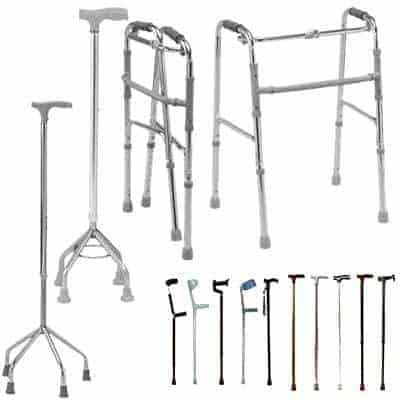Equipment for disabled people is functional to the point of being “institutional” says a new survey from Blue Badge Style. The results of the latest BBS Interest Panel, set up to find out about the opinions of the disabled community on both mobility and household equipment, found that the available products are generally considered “not fit for purpose or ugly”. The situation was found to be pretty dire, with one of our panellists summarising that “I cannot find a walking aid that is both practical and stylish and neither can the NHS”.
The qualitative survey, conducted late last year but released today, probed respondents’ frustrations with equipment and how suppliers could work harder to deliver against expectations. The choice of stylish and practical equipment is considered to be slim to none, with respondents saying that disability aids are “dull”, “functional” and “inelegant”. Both home and mobility equipment are believed to be very functional and lacking not only in style but also in choice with more than 80% of respondents finding both home and mobility equipment very functional.

Almost three-quarters of respondents felt that there is not enough choice in either home or mobility equipment and most of these feel very strongly on the subject. Nearly all of respondents would be interested in products offering both functionality and style, with more than 50% of these feeling very strongly. Panellists agreed that, although they would not exchange an item for a new style or colour, it would be a consideration when buying. Although there was a strong belief that style should be the norm, the majority of those responding to the study would be willing to pay more for stylish products, if only they were more widely available.
About half of our respondents spend £200-£500 on home equipment per annum and upwards of £1,000 per annum on mobility equipment, so this is a significant spend going on products that are often unattractive and failing to live up to expectation. Dissatisfaction usually only relates to two or three purchases in a year, but frustration is high and more choice is desired by all, even when there are stylish products available. Only 20% of respondents state that they are never disappointed in home equipment purchases.
There is a strong feeling that equipment is marketed for a negative image of what it means to be disabled and is therefore very institutionalised, with respondents saying they feel that the equipment itself looks “disabled” and “stereotyped”. “I hate the way disabled aids are so inelegant and old fashioned,” one panellist commented. “[They] look like they belong in an old peoples home in the 1970’s”. It was put forward that suppliers can play a role in changing the perception of disability products by not marketing them as disabled but maybe as lifestyle instead. An image change on this level could increase the level of style expected by producers and customers.

Although almost all felt that style should be the rule rather than the exception, nearly two-thirds of those who would be interested in buying more stylish equipment would also be willing to pay more to do so. Some respondents would be willing to pay far more if it makes them feel more inclusive in society and provides self-esteem and those not willing to pay more at all tend to be older and on limited budgets. The general consensus was that a 10-20% price premium is expected but it does depend on the item and the base price, working on a case by case situation and is very much about “what will it do for me”.
Among the many difficulties for disabled people looking for stylish equipment is that finding such products is just the first problem. One of the main frustrations felt is that it is not always possible to try before you buy. This means that searching online is the most popular research tool with little difference between home and mobility equipment for the channels used for research and little option of other methods for research.

It was revealing that the survey found that while price, style, quality and functionality are important in the decision making process, none of our respondents rank brand as a criteria and although medical endorsement is a criteria for a few it is not one of the top considerations. Celebrity endorsements, something that some mobility companies have sought to utilise (particularly in the wake of the London 2012 Paralympics), are of as little interest as brand.
Helen Davies of Pink Flamingo Shopper, the research agency who conducted the study, found “both functionality and style are important to respondents. Currently style equates to expensive in a market where equipment is already perceived as expensive. Respondents often struggle to find equipment that fits with their lifestyle and they are frustrated by the lack of choice. Disabled people are as style conscious as the able bodied and they expect equipment suppliers to understand and respond to their needs”.
The survey’s results were a stark reminder of the state of the disabled equipment market. According to DLF (Disabled Living Foundation) statistics from 2008 the disability equipment market is valued at £1.46Bn and growing at an estimated 9% pa. For such a market there is a distinct lack of choice – one can either buy something affordable and dull or stylish, expensive and difficult to track down, with little to no middle ground.
The BBS Interest Panel has shown that equipment is another area in which the disabled community is being let down. The conclusion is simple: disabled people care far more about style than the people providing disability equipment seem to realise. It isn’t all negative, there is stylish equipment out there for people with disabilities. There are options out there, but as this survey shows once again, they are still far too few and far between. Disabled people are style conscious but the vast majority of disabled equipment providers are unconscious when it comes to fashion. It’s time for them to wake up and start looking to bring some style to the market!

Hello,
Yup the equipment is not a work of art; the NHS equipment is functional and designed to help the patient who has a problem.
I agree that there is a lot of money in the disabled market. Sadly there is very little advertising done to say that an item could help a disabled person. Take OXO Good Grips kitchen equipment, It is very practical, easy to use, great for disabled people but never promoted in the disabled magazines. I wonder why?
I think we need to get the disabled magazines to promote good and interesting equipment and less on catheters, pads, hoists etc. On my website, aid4disabled.com, I do identify things to help a disabled person and give them a better quality of life. These items do the job and the vast majority are not bland/boring. Also they are at prices that people can afford.
Incidentally I have secondary progressive multiple sclerosis so I understand the need for equipment to help disabled people
Why does all disabled equipment have to be so ugly and is always plasticky looking with white and pale blue the colours offered. Surely most people want it to fit into their homes easily, so should be available in different colours. I don’t want my home to look like a hospital so avoid a lot of aids.
The fact that most disability products are fugly is very distressing. It shows a lack of concern or care for people with disabilities in the sense that there is no consideration for developing or designing options. It’s as if there is a mentality that “that’ll do them” or “why do you need options”. There seems to be an assumption that people with disabilities have no taste or style. It is very disrespectful actually. Most products are probably designed by the medical profession, OTs etc. Why not engage industrial designers, architects and interior designers and open a dialogue to creating products that have both form and function. Its a growing market and people with disabilities are craving choice and options. There are so many ways to include products that are beautiful. We want our homes to be sanctuaries not nursing home look alikes. Change can only come about by awareness from the industries that create the products. We need to be more vocal. 🙂